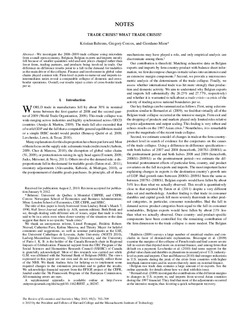| dc.contributor.author | Behrens, Kristian | |
| dc.contributor.author | Corcos, Gregory | |
| dc.contributor.author | Mion, Giordano | |
| dc.date.accessioned | 2015-02-23T11:29:06Z | |
| dc.date.accessioned | 2015-03-04T07:38:41Z | |
| dc.date.available | 2015-02-23T11:29:06Z | |
| dc.date.available | 2015-03-04T07:38:41Z | |
| dc.date.issued | 2013 | |
| dc.identifier.citation | Review of Economics and Statistics 2013, 95(2):702-709 | nb_NO |
| dc.identifier.issn | 0034-6535 | |
| dc.identifier.uri | http://hdl.handle.net/11250/278339 | |
| dc.description | With permission from publisher.
© 2013 by the President and Fellows of Harvard College and the Massachusetts Institute of Technology | nb_NO |
| dc.description.abstract | We investigate the 2008–2009 trade collapse using microdata
from a small open economy, Belgium. Belgian exports and imports mostly
fell because of smaller quantities sold and unit prices charged rather than
fewer firms, trading partners, and products being involved in trade. Our
difference-in-difference results point to a fall in the demand for tradables
as the main driver of the collapse. Finance and involvement in global value
chains played a minor role. Firm-level exports-to-turnover and imports-to-
intermediates ratios reveal a comparable collapse of domestic and cross-
border operations. Overall, our results reject a crisis of cross-border trade
per se. | nb_NO |
| dc.language.iso | eng | nb_NO |
| dc.publisher | Massachusetts Institute of Technology Press | nb_NO |
| dc.title | Trade crisis? What trade crisis? | nb_NO |
| dc.type | Journal article | nb_NO |
| dc.type | Peer reviewed | nb_NO |
| dc.date.updated | 2015-02-23T11:29:06Z | |
| dc.source.pagenumber | 702-709 | nb_NO |
| dc.source.volume | 95 | nb_NO |
| dc.source.journal | Review of Economics and Statistic | nb_NO |
| dc.source.issue | 2 | nb_NO |
| dc.identifier.doi | 10.1162/REST_a_00287 | |
| dc.identifier.cristin | 1045436 | |
